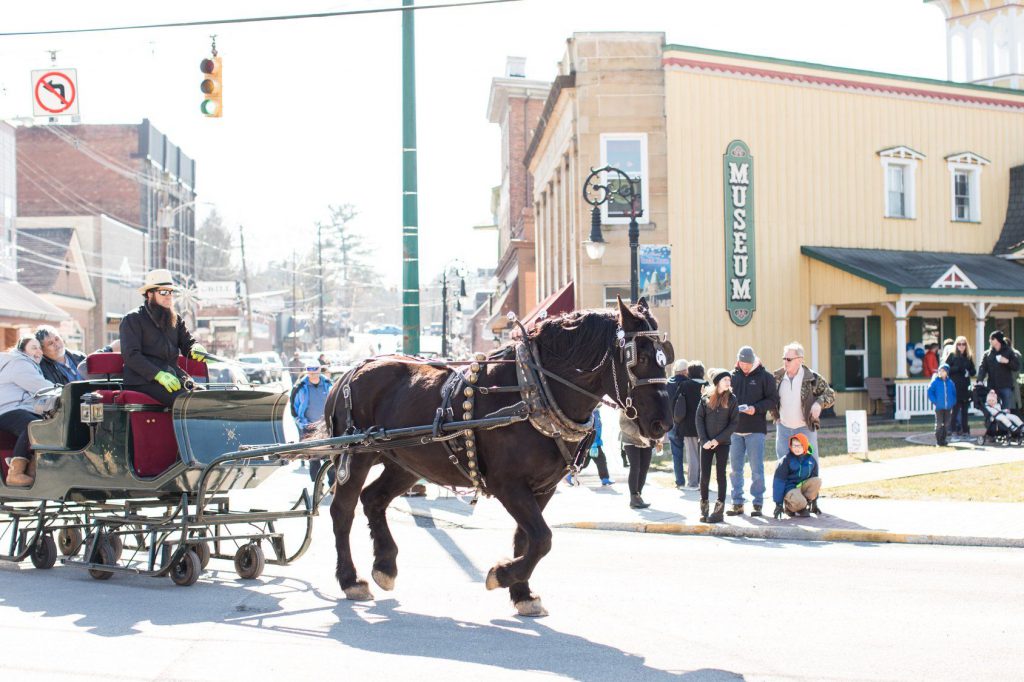Tag: garrett county
Regional 'Make It in the Mountains' Campaign Launches to Boost Outdoor Industry Growth
Allegany and Garrett counties in Western Maryland have unveiled an ambitious regional business and workforce attraction initiative called Make it! In the Mountains. This innovative marketing campaign aims to draw lifestyle manufacturing companies to the region, leveraging its natural assets and outdoor recreation opportunities. The initiative, which includes a newly launched website – MakeItInTheMountains.com, is a strategic move towards fostering economic development and growth within the outdoor industry.
Backed by a $75,000 grant from the Appalachian Regional Commission (ARC), awarded in January 2022, Allegany County Government, Garrett County Government, and the Maryland Department of Commerce have collaborated on this joint venture titled ‘Elevating the Outdoors: A Regional Approach to Growing Western Maryland’s Outdoor Economy’. The grant supported the development of a comprehensive recruitment and strategic plan aimed at attracting outdoor recreation/lifestyle manufacturing companies to establish and expand their operations in Western Maryland.
Maryland Commerce Secretary Kevin Anderson expressed enthusiasm for the initiative, highlighting its potential to drive business investment and tourism spending in the region. The project aligns with recommendations outlined in the State of Maryland’s Maryland Outdoor Recreation Economic (MORE) Commission report, released in December 2019, which emphasized the importance of attracting outdoor lifestyle manufacturers to the state.
The initiative has received strong support from local authorities, with Paul C. Edwards, Chairman of Garrett County Commissioners, emphasizing the region’s suitability for businesses in the outdoor recreational space. Allegany and Garrett counties boast a wealth of natural resources, including over 150,000 acres of public land, extensive trail systems, and multiple state parks, positioning Western Maryland as an ideal destination for outdoor-focused businesses.
The project has resulted in the development of a detailed manufacturing analysis, tourism analysis, and a strategic recruitment plan. Key deliverables include the launch of the MakeItInTheMountains.com website, which serves as a central platform for promoting the region’s assets to potential investors and businesses.
Ashli Workman, Director of Tourism for Allegany County, highlighted the collaborative efforts between the two counties in leveraging their natural resources for economic development. The initiative reflects a concerted regional approach towards attracting business and fostering workforce development, leveraging the shared strength of the region’s outdoor amenities.
Funding for the project was provided by Allegany County Government, Garrett County Government, and the Maryland Department of Commerce. A dedicated workgroup comprising representatives from the funding agencies, including Jeffrey Barclay, Kim Durst, Marci Ross, Andrew Sargent, Siera Wigfield, and Ashli Workman, played a pivotal role in driving the initiative forward. Additional support from Steve Kelly, Director of Community Development, and Sarah Duck, Vice President of Tourism & Marketing at the Garrett County Chamber of Commerce, along with consultancy services from Downstream Strategies and InnerAction Media, further contributed to the success of the project.
Copies of the manufacturing analysis, tourism analysis, and strategic/recruitment plan are available for reference on the MakeItInTheMountains.com website, offering valuable insights into the region’s potential for outdoor industry growth.
In conclusion, the launch of the ‘Make It in the Mountains’ campaign represents a significant milestone in Western Maryland’s pursuit of economic development through the outdoor industry. By capitalizing on its natural assets and collaborative spirit, the region is poised to attract businesses, create jobs, and enhance its position as a premier destination for outdoor enthusiasts and entrepreneurs alike.

GCPS Readies for Southern Area Grade-Band Alignment: Introducing the Broad Ford Elementary 6th Grade Academy
changes are on the horizon for sixth-grade students in the southern area of Garrett County Public Schools (GCPS). On January 26, 2024, GCPS administrators convened to further refine plans for the grade-band alignment, particularly focusing on 6th grade and Broad Ford Elementary. Set to commence in the 2024-2025 school year, this transition marks a significant milestone in the educational landscape of the region.
In preparation for this transformational shift, GCPS is gearing up to unveil comprehensive details in the upcoming weeks. Among the key areas of focus are program overviews, daily schedules, and logistical specifics tailored to the unique setting of the Broad Ford Elementary School. Let’s take a closer look at what awaits students at the Broad Ford Elementary 6th Grade Academy.
The academic framework at the Broad Ford Elementary 6th Grade Academy is designed to optimize learning outcomes and cater to the diverse needs of students. Here’s a glimpse into what students can expect.
One of the hallmark features of the academy is its departmentalized instructional model. Students will rotate between core English, Math, Science, and Social Studies classes, each taught by specialized teachers. This approach allows educators to delve deeper into their respective content areas and deliver targeted instruction.
Recognizing the importance of catering to individual learning styles and abilities, the academy offers varying academic levels, including honors, general, and merit tracks. This ensures that every student receives instruction tailored to their specific needs, fostering academic growth and success.
To provide additional support and address learning gaps, students will participate in a dedicated intervention block. This focused time allows educators to provide targeted assistance and remediation, ensuring that all students have the opportunity to thrive academically.
Aligned with Maryland regulations, the curriculum encompasses all core subject areas, including English Language Arts (ELA), Math, Science, and Social Studies. Additionally, students will engage in a fine arts class and Physical Education/Health, ensuring a well-rounded educational experience.
The academy places a strong emphasis on student choice and enrichment. With eight blocks of time available, students are encouraged to explore a diverse range of elective courses, including Computer Science, Technology Education, General Music, Band, Chorus, Theatre, and Visual Art. Most electives will follow a quarterly rotation, allowing students to sample various subjects throughout the year.
Electives will follow an A day/B day rotation, providing students with the flexibility to pursue their interests while maintaining a balanced schedule. Whether participating in band rehearsals, honing their artistic skills, or exploring the world of technology, students have ample opportunities for personal and academic growth.
Special Olympics Maryland's First Annual Community Dunk
Join us on February 22, 2024, for an exhilarating and heartwarming event as Special Olympics Maryland – Garrett County hosts its inaugural Community Dunk at Deep Creek Lake. Local daredevils will brave the icy waters, all for a great cause – supporting the athletes and Unified® teammates of Special Olympics Maryland.
Thursday, February 22, 2024 3:00 PM – Registration 4:00 PM – Dunk Cost: Pay or raise $75 to dunk and receive a complimentary sweatshirt/meal coupon
Be a part of Deep Creek’s newest tradition by sponsoring the dunk! This event is not just about icy plunges; it’s an opportunity for businesses and organizations to make a significant impact in the community. By becoming a sponsor, you contribute to the success of Special Olympics Garrett County and Special Olympics Maryland Winter Games at WISP.
Through partnership, your organization can play a vital role in promoting a world of opportunity and advocating for the inclusion of individuals with intellectual disabilities. Special Olympics Maryland is dedicated to building mutually beneficial relationships with sponsors who share our values of corporate social responsibility, team building, brand development, and business growth.
Why Sponsor?
- Community Impact: Your sponsorship directly benefits the athletes of Special Olympics Garrett County and the broader Winter Games at WISP. Make a positive impact in the lives of individuals with intellectual disabilities and their families.
- Brand Building: Align your brand with a cause that resonates with the community. Showcase your commitment to social responsibility and inclusivity.
- Team Building: Engage your team in a unique and exciting experience. Participating in the Community Dunk fosters teamwork, camaraderie, and a shared sense of accomplishment.
- Business Development: Connect with the local community and build relationships with potential customers. Supporting Special Olympics Maryland demonstrates your commitment to making a difference where it matters.
Ready to take the plunge? Register for the Community Dunk today and secure your spot in this extraordinary event. Whether you’re an individual looking for a chilly challenge or a business eager to sponsor and make a lasting impact, your involvement is crucial. Register here: 2024 Community Dunk – Campaign (somd.org)
The first annual Community Dunk promises to be an unforgettable experience, filled with courage, camaraderie, and a whole lot of heart. Together, let’s make a splash for a cause that truly matters. Join us on February 22, 2024, at Deep Creek Lake and be a part of Special Olympics Maryland’s commitment to creating a more inclusive and supportive community.
Don’t miss the chance to dive into something extraordinary – register today and help us make a difference!
Garrett County Health Fair & Family Fun Festival Promises a Day of Wellness and Fun
The Garrett County Health Fair & Family Fun Festival is more than just an event – it’s a community-driven initiative aimed at fostering health awareness and promoting the abundance of health-oriented resources available throughout the local community. This free community event welcomes all ages, encouraging families to come together and prioritize their well-being.
Sarah Bush, Steps Committee Chairman and Community Development Coordinator with Aetna Better Health of Maryland, urges the community not to miss out on this health-focused extravaganza. “Get the Health Fair marked on your calendar now, so you don’t miss it. There will be something for all ages, so make it a family event!”
What to Expect: The Health Fair and Fun Festival will feature a diverse array of informational booths, offering valuable insights into health and wellness. Attendees can take advantage of some free health screenings, participate in exciting door prize giveaways, and receive complimentary items from various vendors. Stay updated on event details by following the Garrett County Health Fair on Facebook or visiting garretthealth.org/health-fair.
Free and Supported by Sponsors: This inclusive event is free for all participants, thanks to the generous support of sponsors committed to community well-being. Vendor and sponsorship packets will be emailed to previous participants, providing an opportunity for local businesses and organizations to contribute to the success of this community-driven initiative.
Commitment to Community Wellness: The Garrett County STEPS Committee, comprised of local businesses, public agencies, and private citizens, shares a common goal – to enhance the overall wellness of the community. By organizing events like the Health Fair and Family Fun Festival, the committee aims to create a healthier, more informed, and connected community.
Conclusion: As the Garrett County Steps to Better Health Committee invites everyone to save the date for April 6, 2024, anticipation is building for a day of health-focused activities, family fun, and community engagement. The Health Fair and Family Fun Festival is an opportunity for individuals and families to prioritize their well-being while discovering the wealth of health resources available in the local community. Be part of this uplifting event, and let’s take a collective step towards a healthier, happier Garrett County.
The Garrett County Steps to Better Health Committee has exciting news for the community! Mark your calendars for Saturday, April 6, 2024, as the date for the eagerly awaited Garrett County Health Fair and Family Fun Festival. This year’s event is set to take place at the CARC (Community Aquatic & Recreation Complex) at Garrett College in McHenry from 8:30 AM until 12:30 PM, promising a morning filled with health awareness, family-friendly activities, and community engagement.
The Garrett County Health Fair & Family Fun Festival is more than just an event – it’s a community-driven initiative aimed at fostering health awareness and promoting the abundance of health-oriented resources available throughout the local community. This free community event welcomes all ages, encouraging families to come together and prioritize their well-being.
Sarah Bush, Steps Committee Chairman and Community Development Coordinator with Aetna Better Health of Maryland, urges the community not to miss out on this health-focused extravaganza. “Get the Health Fair marked on your calendar now, so you don’t miss it. There will be something for all ages, so make it a family event!”
The Health Fair and Fun Festival will feature a diverse array of informational booths, offering valuable insights into health and wellness. Attendees can take advantage of some free health screenings, participate in exciting door prize giveaways, and receive complimentary items from various vendors. Stay updated on event details by following the Garrett County Health Fair on Facebook or visiting garretthealth.org/health-fair.
This inclusive event is free for all participants, thanks to the generous support of sponsors committed to community well-being. Vendor and sponsorship packets will be emailed to previous participants, providing an opportunity for local businesses and organizations to contribute to the success of this community-driven initiative.
The Garrett County STEPS Committee, comprised of local businesses, public agencies, and private citizens, shares a common goal – to enhance the overall wellness of the community. By organizing events like the Health Fair and Family Fun Festival, the committee aims to create a healthier, more informed, and connected community.
As the Garrett County Steps to Better Health Committee invites everyone to save the date for April 6, 2024, anticipation is building for a day of health-focused activities, family fun, and community engagement. The Health Fair and Family Fun Festival is an opportunity for individuals and families to prioritize their well-being while discovering the wealth of health resources available in the local community. Be part of this uplifting event, and let’s take a collective step towards a healthier, happier Garrett County.
Oakland's Winter Fest 2024: A Spectacular Blend of Ice, Wine, and Family Fun
The charming town of Oakland is gearing up for its much-anticipated annual Winter Fest, set to take place on February 17, 2024, from 11:00 AM to 4:00 PM. This year promises an exciting lineup of activities, including the return of the beloved Winter Fest Wine Walk, live music and performances, kids’ activities, and the highly anticipated revival of the stunning ice sculptures.
A highlight of this year’s Winter Fest is the revival of hand-carved ice sculptures by The Ice God team from Baltimore, Maryland. After a hiatus since 2020 due to the COVID-19 pandemic, these breathtaking sculptures will once again grace the downtown area, capturing the attention of all attendees. The Ice God team’s intricate carvings will be strategically placed around town, some even designed for interactive engagement. Those interested in having a personalized ice sculpture can contact Nicole at City Hall for information and pricing.
Kicking off at 11:00 AM, the Winter Fest Wine Walk promises to be a delightful experience for wine enthusiasts. Tickets, priced at $25, can be purchased both online in advance and on the day of the event at the gazebo in Oakland. Ticket holders will have the opportunity to savor 16 different wines at eight distinct locations, including the Oakland B&O Museum, The Gallery Shop, Tomanetti’s Pizzeria & Italian Eatery, The Vagabond Taproom, 206 Alder, Stephanie’s Sweet Shop, Smoke N Mirrors Photography, and the Mountain Fresh Farmers Market. Maps will be provided at registration for easy navigation.
Beyond the sculptures and wine tasting, Winter Fest is packed with family-friendly activities to ensure everyone’s enjoyment. Local artists, including the talented Keen & Bright glass blower, will be showcasing their skills. Kids can engage in crafts and activities, while a face painting station adds a touch of whimsy. A bounce house and obstacle course, courtesy of local support, promise an afternoon of laughter and play. Additionally, a hot cocoa station provided by Boy Scout Troop 1, free carriage rides, and more surprises await attendees.
For those eager to delve into Oakland’s rich history, the Oakland Historical Society Museum, Transportation Museum, and Oakland B&O Museum will be open from 10:00 AM to 3:00 PM, offering insights and tour opportunities.
Winter Fest is made possible through the collaborative efforts of the Greater Oakland Business Association and the Town of Oakland, with support from various organizations, including participating businesses in the Wine Walk, ice carving sponsors, the Garrett County Arts Council, the A&E District of Oakland, the Ruth Enlow Library, the Garrett County Historical Society Museums, the Mountain Fresh Producers Association, Patriot Automotive Group, The Painted Cupboard and The Chic Shack, Alder Street Apartments, and more.
Winter Fest 2024 is poised to be a fantastic, family-friendly event, offering a diverse range of activities and entertainment for both adults and children. With the addition of new shops and restaurants in downtown Oakland, along with the charm of several museums, this year’s Winter Fest promises an unforgettable experience for all. For further details, contact GOBA/Main Street at 301-334-2691 or visit www.oaklandmd.com/winter-fest.html. Don’t miss out on this extraordinary celebration of winter in the heart of Oakland!
JUST LISTED 309 L Street
.34 acre building lot in Mountain Lake Park! Former address was 309 L St. Verify all utility information with the town. Lot is owned by Habitat for Humanity and all proceeds from the sale of this lot will benefit future Habitat building projects in Garrett County!
JUST LISTED-257 Marsh Hill Road
If you are looking for a townhome located in the heart of Deep Creek Lake, this is it! This home feels warm and inviting from the moment you enter. Offering a stone propane fireplace, three levels of living space, two en suites, and three and a half baths. Brand new water heater, and new carpeting and paint on the lower level. The location is truly hard to beat, you are within steps of Wisp Ski & Golf Resort, which you can enjoy views of year round. You also have seasonal lake views and lake access for your enjoyment. If all this isn’t enough, the home also boasts a hot tub and a community tennis court. This is a property that offers something for every season! Established rental “Lake Therapy”. Dock slips are assigned via lottery and are available through the association.
HART for Animals Receives 2024 Grant to Expand Lifesaving Spay and Neuter Initiatives in Maryland
HART for Animals, a charitable animal welfare organization based in Western Maryland, has been honored with a 2024 grant from the Maryland Department of Agriculture as part of their ongoing Spay and Neuter Program. This initiative, now in its ninth year of support for HART, aims to address the critical issue of reducing the number of unwanted cats and dogs euthanized in shelters across the state.
Since its inception in 2011, the Spay and Neuter Program, conceived and initiated by the state of Maryland, has made significant strides in curbing the euthanasia rates of animals in the state. The program, backed by the Maryland General Assembly, was introduced to combat the alarming statistics that revealed 50% of cats and 33% of dogs in Maryland’s shelter populations were being euthanized, placing a considerable burden on taxpayers.
HART’s 2024 grant will empower its Lifesaver program to conduct 48 dog spays and neuters, along with 105 cat spays and neuters. This significant contribution will continue to provide no-cost spay/neuter surgeries to low-income residents in Garrett and Allegany Counties, fostering responsible pet ownership and addressing the root cause of the overpopulation issue.
Residents who meet the income-eligibility requirements for the Lifesaver program can now schedule their appointments for this year. Dog and cat owners seeking these services can call 301.387.7729 to secure their spot and contribute to the broader effort of controlling the animal population in Maryland.
The Maryland Spay/Neuter Program was established in 2013 through legislation, responding to the task force’s recommendations and outlining the objectives of providing affordable spay and neuter services throughout the state. The program is funded by fees from the pet food industry, ensuring a sustainable source of support for its vital mission.
Caroline Robison, HART’s Program Manager, emphasizes the importance of spaying and neutering pets in reducing shelter intake and euthanasia rates. Not only does this practice contribute to longer and healthier lives for pets, but it also addresses the risks associated with unaltered animals, such as increased roaming and susceptibility to life-threatening situations.
Dr. Jessy Vandevender, HART’s veterinarian, underscores the health benefits of spaying and neutering, citing reduced risks of certain cancers for both female and male pets. The Lifesaver program, alongside the low-cost HARTHelp initiative, has successfully spayed or neutered 13,790 animals since 2009, making a substantial impact on the reduction of unwanted dogs and cats in the region.
HART for Animals continues to be at the forefront of promoting responsible pet ownership and addressing the issue of overpopulation in Western Maryland. With the support of the 2024 grant from the Maryland Department of Agriculture, HART’s Lifesaver program expands its reach, contributing to a healthier and more sustainable environment for animals and communities alike. To learn more about HART and support their initiatives, visit their website at www.hartforanimals.org.

GC Diversity and Inclusion Committee Meeting Announced
The Garrett County Diversity and Inclusion Committee’s next meeting is Wednesday January 31, 2024 – from 3 PM until 4:30 PM at Garrett College in the Offutt STEM Building in Room 211

Legal Battle Over Swallow Falls Bridge Replacement Plan Continues as Judge Denies DNR's Motion
A recent ruling by Garrett County Circuit Court visiting Judge W. Timothy Finan has allowed opponents of the Swallow Falls bridge replacement plan to proceed with their case against the Maryland Department of Natural Resources (DNR). On Monday, Judge Finan denied DNR’s motion to dismiss a petition that challenges an exception granted by DNR Secretary Josh Kurtz related to the state-protected Youghiogheny River corridor.
The petition, filed in September by Steve Storck, who owns property in the Wild Yough scenic corridor, the Old Growth Forest Network, and Yough Farms LLC, seeks to remove the exception granted by DNR that would permit Garrett County to construct a new bridge on an offset alignment of the existing Swallow Falls span.
Attorney J. Dirk Schwenk of Baylaw, LLC, representing the petitioners, expressed satisfaction with the court’s decision. He stated, “(Finan’s) order means that the court recognizes that these petitioners have standing to challenge the DNR’s decision, and that the court has the power to review it.”
Schwenk emphasized that these early decisions are crucial, as they provide an opportunity for the petitioners to present their case against the exception granted by DNR. The objections raised by the petitioners include concerns about the environmental impact of the offset alignment, which would involve significant clearing, grading, and the loss of trees and habitat along the Youghiogheny River.
The designated wild area between Millers Run and the southern corporate limits of Friendsville is subject to a management plan and regulations governing its use and development. The petition argues against activities such as damming, dredging, filling, channelization, or other alterations of the river or its banks, except those involving the repair of existing bridges.
In October, Garrett County joined DNR in seeking the dismissal of the petition, claiming it failed to state a claim under which relief could be granted. The motion argued that the Scenic and Wild Rivers Act does not provide for judicial review, DNR’s decision is not quasi-judicial, and the petitioners lack standing for administrative mandamus claims.
However, Judge Finan’s recent decision to deny DNR’s motion indicates that the court believes the petitioners have a valid case to challenge DNR’s decision. Storck, in response to the court decision, attributed it to the presentation of a strong case by Schwenk and criticized DNR for defending what he called “the indefensible.”
DNR Media Relations Manager Gregg Bortz responded to the ruling by stating that the department appreciates the court’s time and will evaluate its options but is prepared to present its case at the upcoming hearing. Judge Finan is scheduled to preside over the issue on April 2 and 3, marking the continuation of the legal battle over the Swallow Falls bridge replacement plan.
















